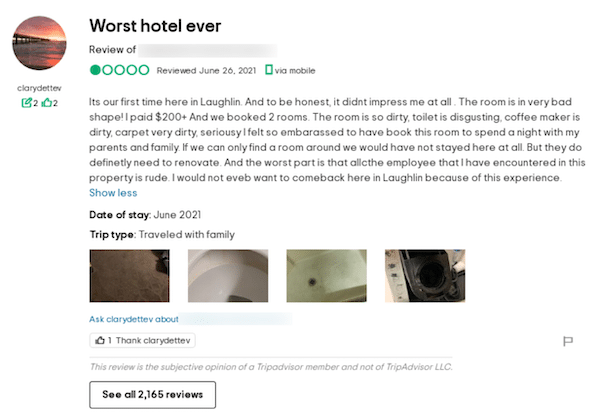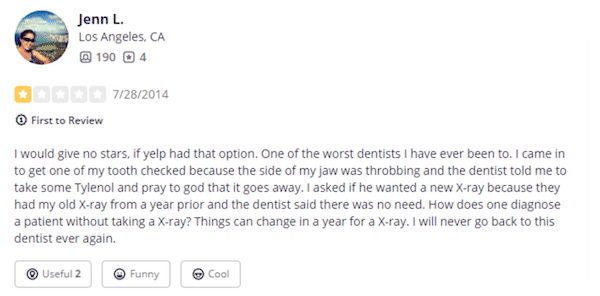A local restaurant has just been flooded with negative reviews.
A generous diner decided to leave a $16,000 tip for a waitress after eating his $37 meal of chili dogs and fries. This diner felt their waitress was deserving of their incredible gift.
So why the negative reviews?
According to the Independent, “The owner of the New Hampshire bar told local media that he and his staff were overwhelmed by the anonymous man’s generosity and that the money would be split among workers.”
Numerous customers were outraged.
Disaster is how many small businesses begin reputation management
This isn’t every business.
However, many inexperienced small businesses place reputation management on the back burner, at least until they’re forced to address the problem. Those who choose to wait are forced into the tough position of digging themselves out of a hole when negative reviews ambush them.
This is the problem.
Disaster is often the primary motivator for many of these businesses, particularly those in the service industry. Am I saying these businesses ignore reviews completely?
It’s more complex than that.
Businesses are losing customers and revenue due to:
- No reviews: These are new businesses that fail to establish any kind of review portfolio online. They haven’t claimed their profile on any mainstream review site.
- Low reviews: A large majority of small businesses fit in this category; they have a sprinkling of reviews on a few review sites but nothing to give customers a true sense of their business or their brand.
- Imbalanced reviews: These are businesses with a strong review profile on one or two review sites. They’re very active on Yelp, but they’ve neglected Google or TripAdvisor.
It gets worse.
Research from Moz found businesses risk losing as many as:
- 21.9% of customers if you have just one negative review listed on page one of Google
- 44.1% of customers if you have two negative results
- 59.2% of customers with three negative results
- 69.9% of customers with four negative results
What does this mean?
If you have no reviews, low reviews, or an imbalanced review portfolio, you’re losing customers, traffic, and revenue. If you’re unlucky enough that you receive a string of negative reviews before your review portfolio is established, the problem compounds, accelerating your loss.
Are all businesses doing this?
A growing number of small businesses, especially those in hospitality, understand the power of reviews. These brands understand the devastation that comes with a flood of negative reviews. When they build their business, they do their best to build a strong reputation online from the get-go.
Still skeptical?
Why your small business needs reputation management
What exactly is reputation management?
The term “reputation management” is an all-encompassing term that describes a few disciplines:
- Review management
- Crisis management
- Press and PR
As businesses have become more knowledgeable, they’ve realized they need both ends of the reputation management spectrum.
This is an important distinction to make.
The more time your small business spends on proactive reputation management, the easier it is to attract new customers, and the cheaper reactive reputation management will be.
It’s really about value.
- Businesses with more than nine fresh reviews (posted within the past 90 days) earn 52% more than average, and those with more than 25 reviews make 108% more than average.
- A star rating increase of 0.1 can increase your conversion rates by 25 percent
- 40.56% of your local rankings in Google depend on your Google My Business (GMB) account and review signals
- Buyers expect a minimum of 40 online reviews (average) before they will believe your star rating is accurate
- What about ecommerce? Shoppers expect an average of 112 reviews (per product) when they search online
- Those in the 18 to 24 age ranges expect 203 reviews per product
- 85% of consumers think online reviews that are older than three months aren’t relevant
Your customers want to see reviews; Google wants to see online reviews. Meet their expectations, and you’re rewarded with more traffic, leads, customers, and revenue.
What reputation management does for your small business
Is the whole management thing really necessary? Can’t you just ask a few customers for reviews, post them online and call it a day?
Actually, no.
A properly structured reputation management campaign will show you:
- What your customers like/dislike about your product, service, or business
- What your competitor’s customers like/dislike about their product, service, or business
- The core issues or challenges that are costing your business conversions, leads, and revenue
- Access to the details customers need to trust your business (e.g., guarantees, reviews, case studies, etc.)
- What customers want from your business but will absolutely refuse to share with you (until they proceed with a public celebration or shaming)
- The specific, actionable steps you should take to 2x, 4x, and even 10x your business
Let me show you what I mean.
Here’s a review of a small hotel that’s listed on TripAdvisor as the Worst Hotel Ever. Pay close attention to the details in this customer’s review.

Treat your negative reviews as instructions.
- The rooms are dirty: This means housekeeping isn’t doing a good job with room turnover
- Each of the employees this customer encountered was rude
- They felt they were overcharged
- These customers took pictures and posted them in their review, inquiries, and traffic to your hotel will begin to fall immediately
- This hotel is adjacent to a casino. In a customer’s mind, they believe you’re cash-rich. In their mind, there’s no reason why you can’t invest the money needed to renovate your hotel.
This customer thinks management is too cheap to renovate their gross hotel and hire new staff.
Let’s look at another example.

This looks bad (and it is).
However, this dentist hasn’t hit the point of no return; their reputation can be salvaged. Here’s a recap of this customer’s complaint (remember to treat negative feedback as instructions):
- The dentist was dismissive during a crisis
- Refused to order an updated X-ray to assess the problem
- Refused to provide adequate care to a customer in severe pain
But wait… there’s more.
This was the first review posted in 2014. Seven years later, there’s still only one review listed on this business’ profile. This business profile hasn’t been claimed on Yelp. There are no photos or videos of the company, no description of the business, and no information on the dentists working here.
This dentist looks completely untrustworthy. They can turn that around by being more transparent with customers and investing some much-needed time and effort to care for their customers.
Here’s the thing about this.
Both positive and negative reviews can come with criticism. It’s still a good idea to treat these complaints as instructions you can choose to act on (or not). Here’s a review a customer left for their automotive repair shop.

- Tim (the owner) is viewed as trustworthy, competent, and conscientious
- His employees not so much (which means his team needs more training)
- Tim is struggling to make the transition from self-employed to business owner
Customers view Tim as trustworthy and competent. They don’t have the same good feelings about Tim’s employees or the quality of work they provide.
How to get started with reputation management
Getting started with reputation management is simple.
First, make a list of the tools and resources you’ll need. Here’s a shortlist of the items you’ll need to run your reputation management campaigns successfully.
- A list of the relevant and top-performing review sites in your industry (mainstream, industry-specific, niche, etc.)
- The people/departments in your organization who will be responsible for managing your reputation
- Media assets (e.g., videos and photos of your business, employee bios, company descriptions, etc.)
- A list of local search keywords you’ll be optimizing your accounts around
- Hours of operation
- Your website address and social media profiles
- FAQs
Next, follow these steps to set up your reputation management campaigns.
- Claim, complete, and optimize your review listings
- Take an inventory of your total number of online reviews
- Search for your business (locally) in Google Maps and Bing. Where does your business show up?
- Set specific quarterly goals (e.g., 50 reviews by the end of Q4)
- Select your reputation management tool of choice
- Create your review request templates and load them into your tool’s autoresponder
- Set your tool to monitor incoming reviews from customers across all platforms (i.e., Google, TripAdvisor, Yelp, etc.)
- Outline review governance (e.g., who’s in charge of reviews — is it marketing, customer service?)
Are you feeling overwhelmed?
Check out our comprehensive guides on managing the process. You can use these to train your team or do the work yourself.
- Your Review Management Agency Guide: The First 30 Days
- Your Review Management Agency Guide: The First 90 Days
- The Ultimate 2021 Review Management Checklist
These guides provide you with the data you need to create and launch your reputation management campaigns in minutes.
Wait a minute.
It feels like we’re missing something, doesn’t it? What do you say to customers after they’ve shared their reviews about your business?
- 11 Review Response Templates For Great Reviews
- How To Respond To Negative Reviews
- Which one is worse? Generic vs. Authentic Responses to Negative Reviews
- How To Get Your Unhappy Customers To Change a Bad Review
Feel free to customize these responses, so they’re a fit for your business.
Successful reputation management begins with a plan
The good Samaritan in our story left a $16,000 tip for his waitress. It created an incredible amount of backlash, prompting this small business to abandon its review profiles. It’s the worst possible decision they could have made.
Their negative reviews could have been beneficial.
It could have been the motivating force this business needed to encourage happy and satisfied customers to share their reviews. This restaurant allowed their negative feedback to force them into hiding.
It was a missed opportunity.
Your story can be different. If your company’s online reputation isn’t where it needs to be, start now. Use this guide to create an easy-to-follow plan you can use to grow your business. With a little know-how and consistent effort, you’ll find it’s easy to attract the five-star reviews your company deserves.









